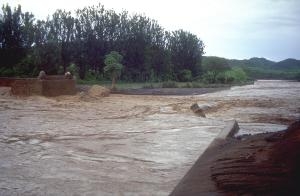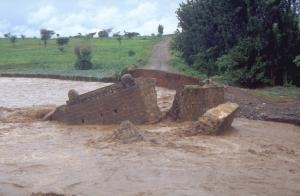I would have liked to have seen Arbore in order to check the clan links between the Arbore and the Rendille, including my own clan affiliation. There are some contradictions. Tadesse explains that there are two villages/co-resident clan clusters, namely Arbore and Marle, with two qawot clans each.
Table 1: Local clustering of the qawot clans among the Hor
|
Hor |
|
|
Arbore |
Marle |
|
qawots: Garle (Kulane village), |
qawots: Huskalach/Fulto (Ergudo), |
The Rendille Gaalorra are iibire, the Rendille equivalent of qawot, i.e., they have a potent curse. They are said to come from Marle, and their nickname, which they dislike, is Marle ti af guduud, "Marle with the red mouth". All this would link them to the Gaalorra of the Hor.
But, in their origin myths, they also claim a connection to Karrayyu, the clan of the Sabbo moiety of the Boran which provides the ritual leader called qallu. One brother went to the Boran and became Karrayyu, the other moved on to the Rendille. Among the Hor, such a link is not claimed by Gaalorra but by Olmog, who are believed to have come from Boran Karrayyu. (Haberland [1963] suggests an alien origin of the Boran Karrayyu, which would mean that it might have been them who came from the Arbore. If we consider, however, that present day ethnic divisions might not correspond to past ones, such distinctions might make little sense.) No link is claimed between Gaalorra and Olmog.
One might, of course, harmonise the two traditions by distinguishing among different eras: at one time Gaalorra split into Hor Gaalorra, Rendille Gaalorra, and Karrayyu; and at some other time Karrayyu split into Arbore Olmog and Boran Karrayyu. But this explanation does not look very elegant. More data are required.
Trying to get back to Arba Minch, we stop by the Dalbena River, which has carried away the bridge. We go back for a few kilometres, leaving the main road to the west of Gawaada (Gewada on the map) for lunch. Then we come back to have another look at the flood, which has not receded, and we go back to Gewada for dinner (see map 12). We spend the night in the school compound close to the former bridge.
|
Waypoint 251 | Lat. 5° 23′ 4.7″ N / Long. 37° 16′ 14.06″ E Location of the former bridge across the Dalbena River |

|

|
Move mouse over pictures to see a larger version with captions
|
Waypoint 252 | Lat. 5° 25′ 58.4″ N / Long. 37° 14′ 18.27″ E Stones erected near Gewada (photograph) |
The Gawaada (Gewada) do not want to remain a part of the Konso Special Woreda (district). They claim to be quite different from the Konso and more like the Tsamako (some of whom we see in Gewada) and also the Ali further up in the mountains to the west.
We are waiting for the flood to recede or for some help to arrive. (The whole of Southern Omo is cut off from the rest of the country, as this is the only road). I collect some vocabulary and paradigms in Konso and Gewada. I am sure that the Konso language has been described many times over, but for me both languages are new. They differ substantially even in some basic vocabulary, such as parts of the body (see table below). On the whole, Konso seems to share more cognates with Oromo.
Table 2: Some Konso and Gewada terms for parts of the body
|
Konsinya |
Gawaada |
English |
|
mata |
p’ukaate |
head |
|
soona |
sinde |
nose |
|
kurra |
qaande |
ear |
|
nyirfa |
qato |
hair |
|
afa |
paake |
mouth |
|
ilga |
ilgi |
tooth |
|
hidd’a |
khibbe |
lip |
|
arraba |
arrawo |
tongue |
|
kholma |
kumaro |
neck |
|
khashita |
khashito |
shoulder |
|
irita |
irite |
arm |
|
harga |
harge |
hand |
|
qubinya |
gote |
finger |
|
sholoqita |
songeeni |
fingernail |
|
duutan |
garetu |
belly |
|
tuld’a |
quude |
back |
|
looqa |
gup’e |
leg, foot |
|
kiliba |
kilibehu |
knee |
